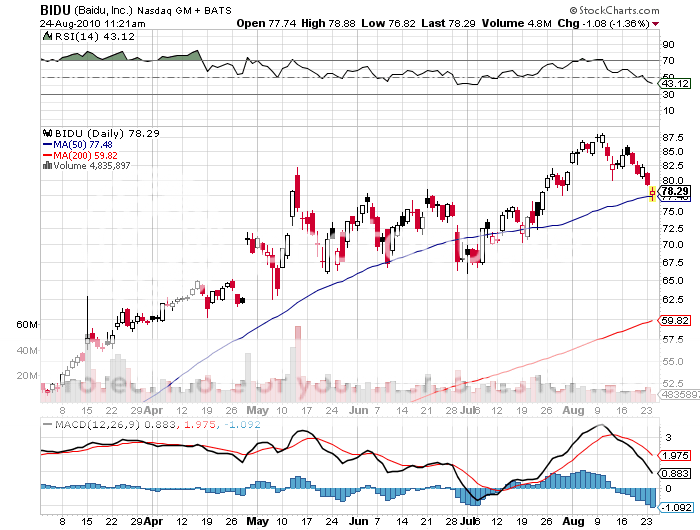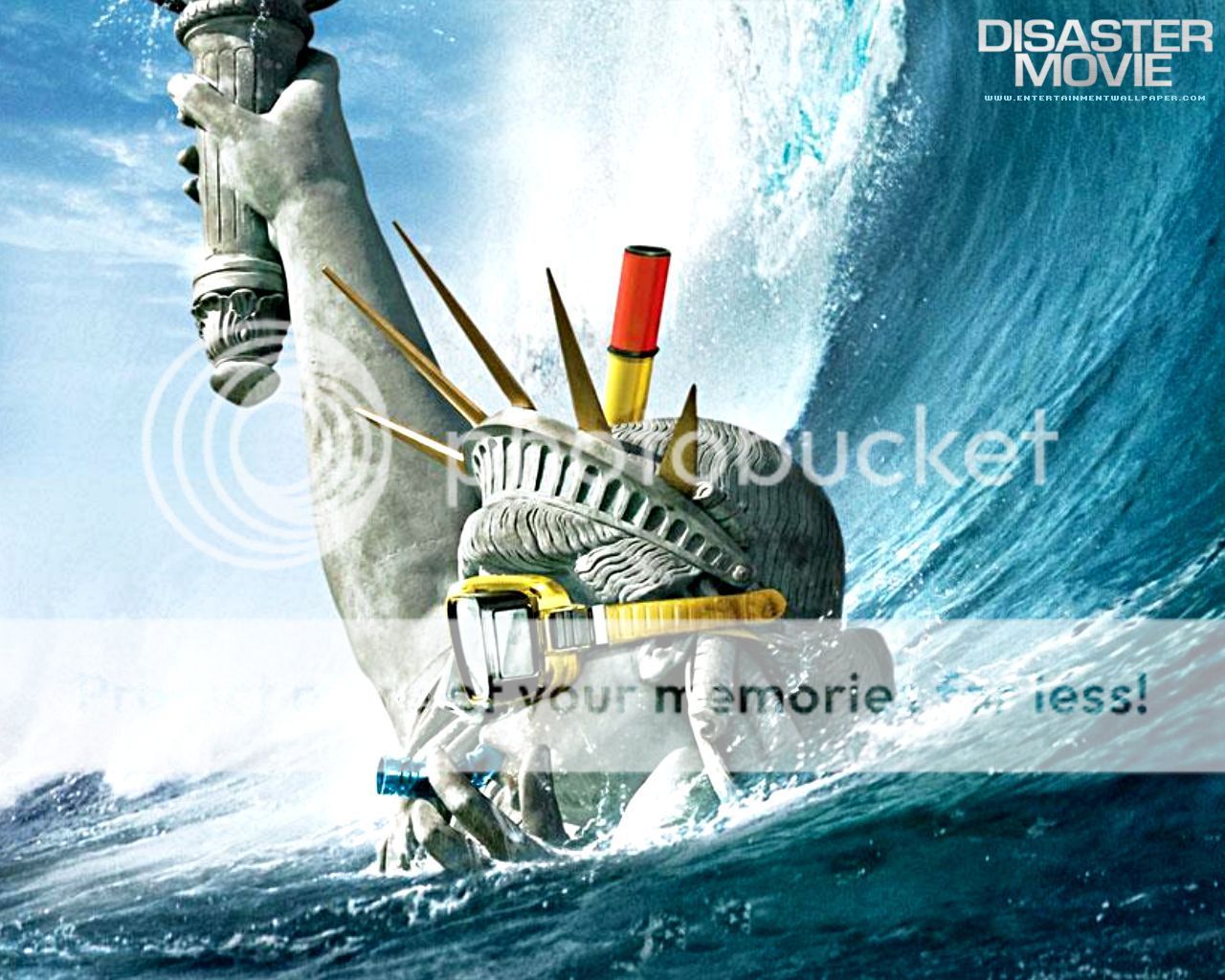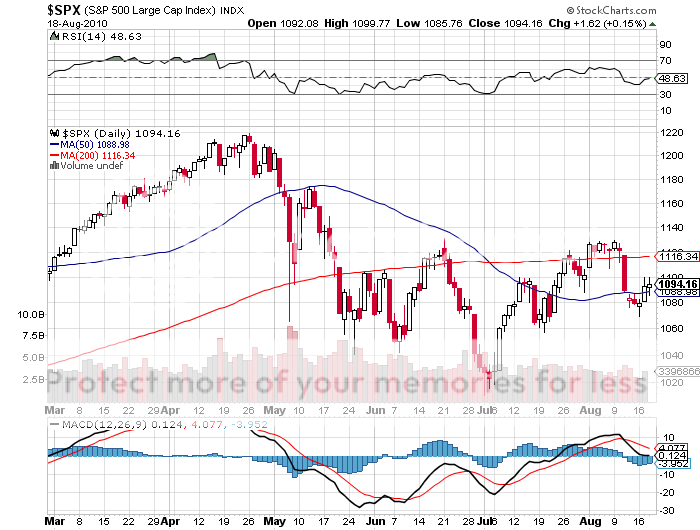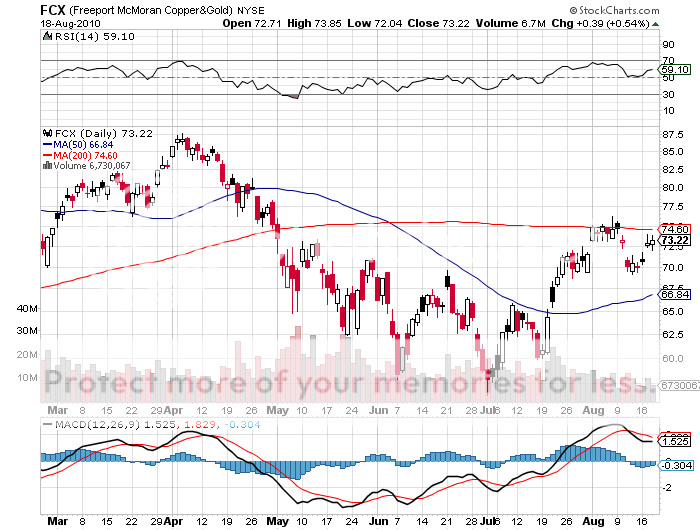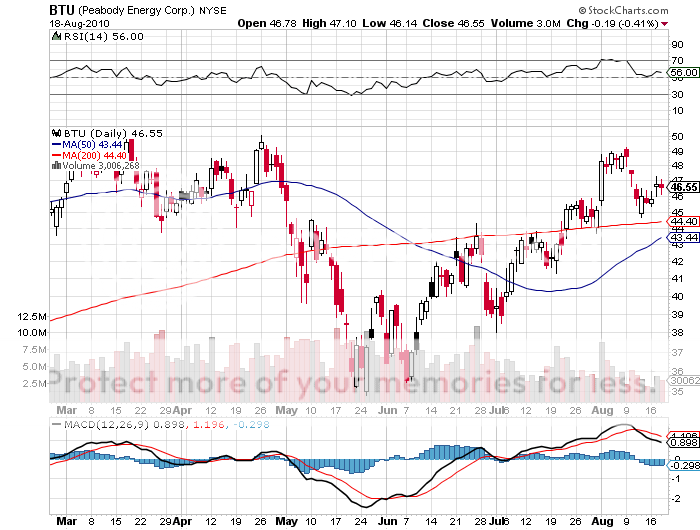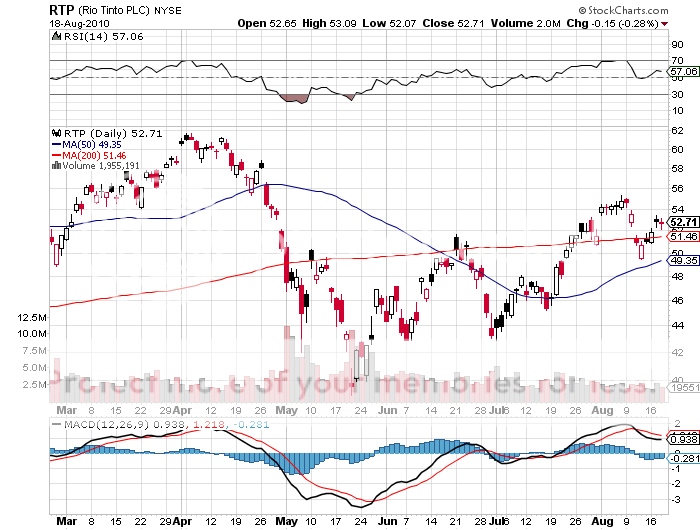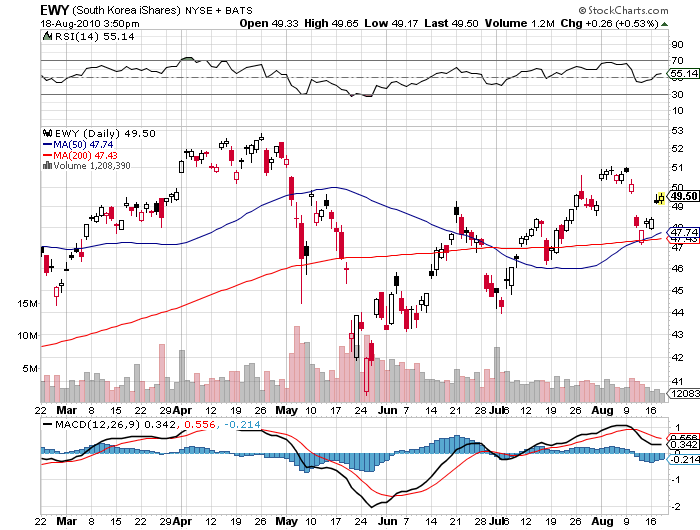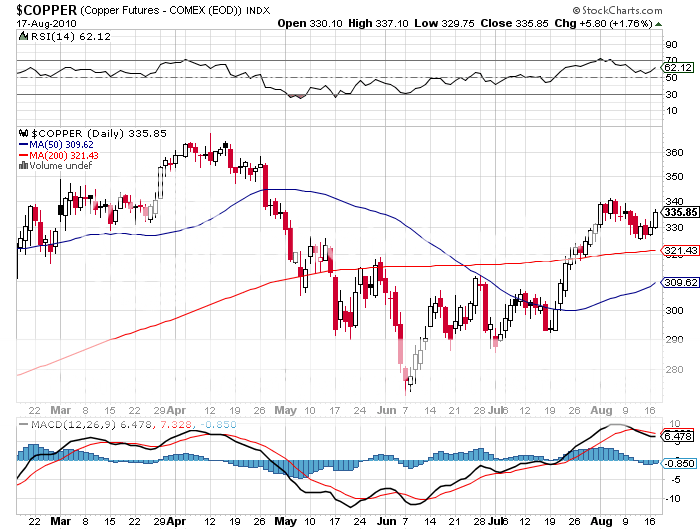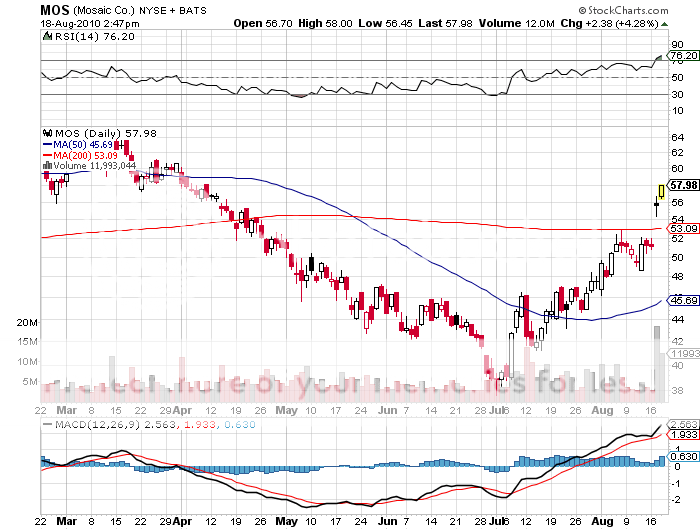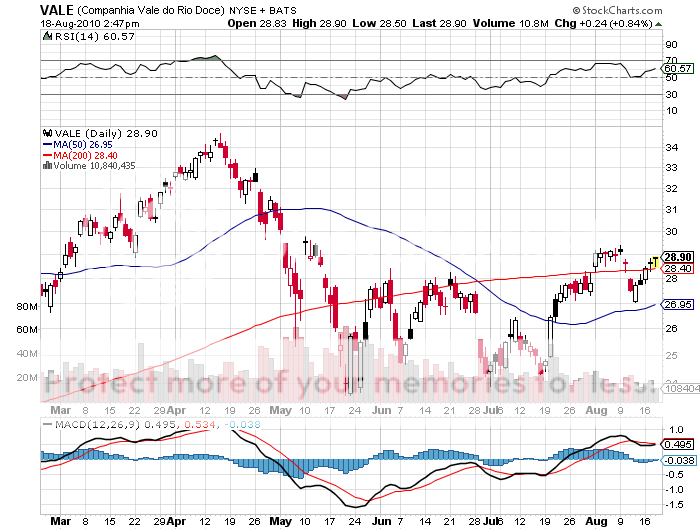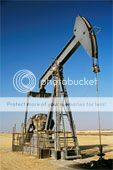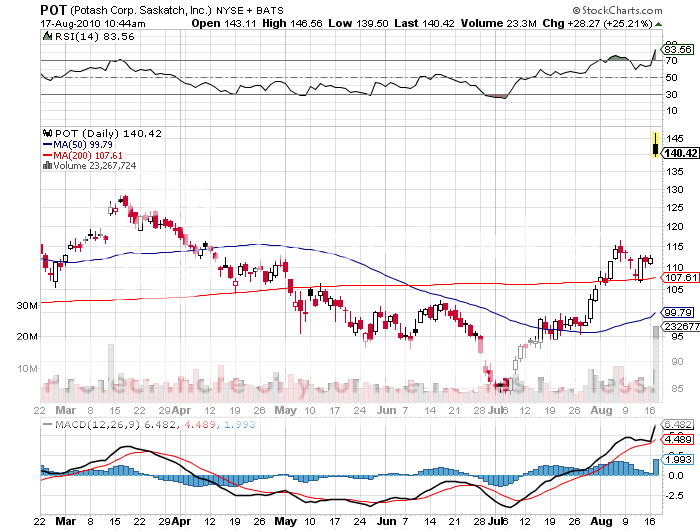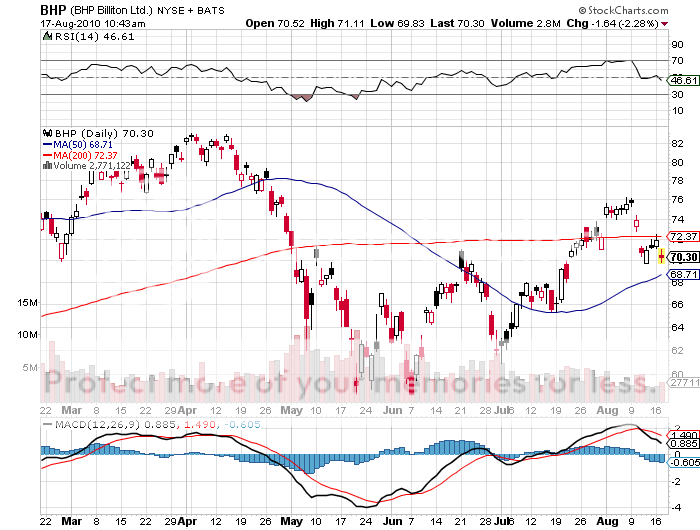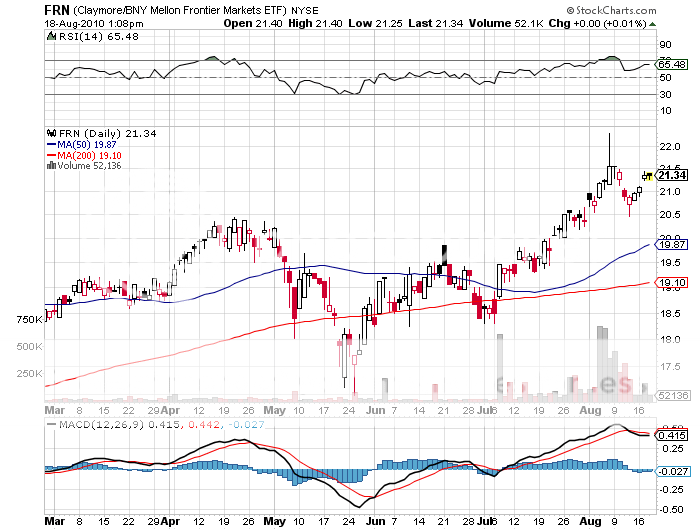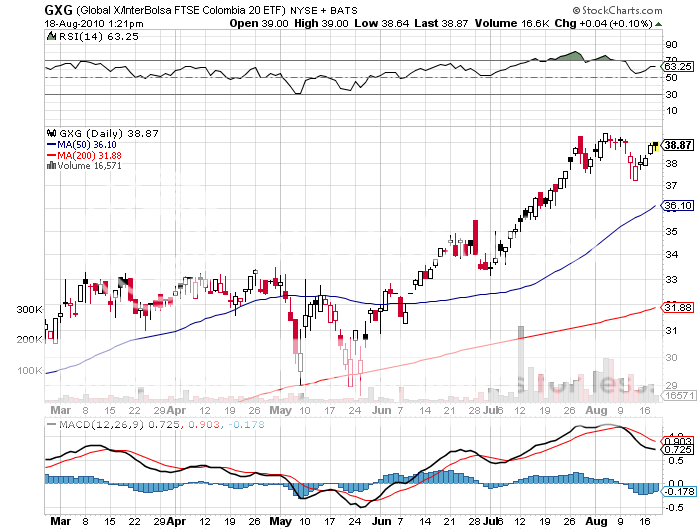
Featured Trades: (BAIDU), (GOOG)
4) Make Another Visit to the Trough for Baidu. Just like buying a drink for an old flame when passing through town, there is no better feeling than revisiting winning trades. I first recommended Baidu (BIDU) at split adjusted $12.5 in December, 2008 (click here for the call). It hit $88 earlier this month, a 700% gain. The current bout of global equity market angst has since knocked 11% off of the shares, and there may still be more downside to go. It may be worth making another visit to the trough. Baidu has incredible momentum selling into the world's fastest growing market for online services, where it has a 65% market share for Chinese language paid search. It has recently expanded into Japan with a powerful Japanese language search engine there. Baidu also brings in peripheral revenues through community based e-commerce, communication, and entertainment. YOY revenues are growing at a 70% rate. No surprise then that Baidu is a favorite trading vehicle for the BSD hedge funds. It is benefiting hugely from the Chinese government's onslaught on rival Google. Sure, a PE multiple of 83 sounds rich, compared to Google's 20, but how much should you pay for a hyper growth company in a country where Q2 GDP came in at 10.3%? Add Baidu to your buy on meltdowns list to get a high beta play in the Middle Kingdom.
'When I look at the Treasury market, I get a really 1998 sort of dotcom feeling. You knew they were going higher, you knew that it would end badly; you just didn't know the timing. At a certain point this becomes a disaster,' said Barry Ritholtz, CEO of hedge fund Fusion IQ.
Featured Trades: (THE RANGEBOUND MARKET),
(SPX), (FCX), (VIX), (USO), (GLD)
1) Why We're on the Slow Boat to Nowhere. After speaking to a gaggle of economists, portfolio managers, and traders the last few days, I've had one of those 'Eureka' moments, as the markets have shown their hands. Those that delivered the dramatic, heart stopping moves last year, like stocks, commodities, oil, and precious metals, are on the slow boat to nowhere. Last year's wall flowers, like currencies and their crosses, will trend nicely, delivering plungers some serious coin.
What's more, I think these trends, or non trends, will continue for the next several months, probably until the November election. That means that the S&P 500 (SPX) will remain around a tedious 1010-1140 range, and that implied volatilities for relevant options will continue to bleed to lower levels. The VIX is probably an outright short here.
This market is a portfolio manager's worst nightmare, and a trader's dream come true. Zero interest rates assure that we aren't going to crash any time soon, and flagging economic data and chronically high unemployment guarantee that we are not blasting out to the upside. They, the nimble and click happy, can confidently sell into every rally and buy each dip. Selling out-of-the-money straddles, last year's suicide trade, could be this year's steady earner. They say markets have to climb a wall of worry. This one has to climb Mount Everest.
Commodities (FCX), oil (USO), and precious metals (GLD) are showing the same indecisive behavior. The cross trades I have been recommending, long Aussie/euro, Canadian/euro, and short the euro/yen, have been delivering reliably all year.
This is all happening because the markets are now transitioning from last year's parabolic 5.7% Q4 GDP rate to the more somnolencent 2%-2.5% growth scenario that I am predicting for this decade. Political gridlock and the attendant noise level don't help either.
You've got to work with the market you have, not the one you want, and these short volatility trades could be your bread and butter for the next several months.
Climbing a Wall of Worry
Featured Trades: (COAL VS. NATURAL GAS),
(BTU), (RTP), (ACI), (CHK), (BNR)
2) Peabody Energy (BTU) Takes a Hatchet to the Natural Gas Industry. After my year in the White House Press Corps, I vowed never to return, and took a really long shower, hoping to scrub every last spec of prejudice, self interest, and institutionalized corruption off of my battered carcass. But sometimes I see some maneuvering that is so unprincipled, crooked, and against the national interest that I am unable to restrain my fingers from the keyboard. For shorthand, let's call them lies.
I'm talking about the absolutely merciless hatchet job the coal producers are inflicting on the natural gas industry. Coal today accounts for 50% of America's 3.7 trillion kilowatts in annual power production. That's a lot of vested interest. Chesapeake Energy's (CHK) Aubrey McClendon says correctly that if we just shut down aging conventional power plants that are over 35 years old, and replace them with modern gas fired plants, the US would achieve one third of its ambitious 2020 carbon reduction goals. The share of relatively clean burning natural gas of the national power load would pop up from the current 23% to 50%. Even the Sierra Club's Carl Pope says this is the fastest and cheapest way to make a serious dent in greenhouse gas emissions.
So what do we get? The press has recently been flooded with exaggerated or untrue reports of widespread well poisonings and forest destruction caused by the fracting processes that was used to recently discover a new 100 year supply of ultra cheap CH4. While the coal industry has had 200 years to build a formidable lobby in Washington, the gas industry is a neophyte, their only public champions being McClendon and T. Boone Pickens.
But memories in Washington are long, and Obama & Co. recall all too clearly that this was the pair that financed the Swift Boat Veterans for Truth that torpedoed Democrat John Kerry's 2004 presidential campaign. What goes around, comes around.
Whose hands are dripping with blood here? Peabody Energy (BTU),? which ripped 200 million short tons of the black stuff out of the ground in 2008, followed by Rio Tinto (RTP) at 140 million tons, and Arch Coal (ARCH) with 134 million tons, poured millions of dollars into Washington to lavishly finance lobbyists. Their mission is to render toothless Cap & Trade legislation, block subsidies for natural gas which both parties seem to agree on, dilute environmental legislation, and promote the myth that the whole global warming thing is nothing more than a leftist hoax, thus keeping hands off King Coal.
Senators and congressmen from the top three coal producing states have been the eager facilitators: Wyoming at 467 million short tons in 2008 (Thanks Dick Cheney!), West Virginia at 157 million tons, and Pennsylvania at 65 million tons. That dinosaur of a union, the United Mine Workers, is another guilty party. You might even blame Warren Buffet's Burlington Northern (BNR), which earns 70% of its revenues from shipping coal across the country for export to China. This is the wellspring for the money that is financing all those conservative initiatives, energy related, or not.
This will be unhappy news for the 23,000 the American Lung Association expects coal emissions to kill this year. How many will clean burning natural gas bump off? None. Can't the coal industry be happy selling everything they rip out of the ground to China? If you are lacking an ounce of conscience and are willing to turn a blind eye to where your trading profits come from, then use the current sell off in all hard assets to pick up (BTU), (RTP), and (ACI). China's demand for our coal remains insatiable, and domestic demand isn't about to go up in smoke overnight either. You can always donate your profits to the Sierra Club. After all, I recommended Russia, why not King Coal.
There! I've had my say. Now I'm going to go have another long shower.
It's a Long Way to Washington
'The good news is that the rash on my penis finally went away,' wrote a child to his parents, about to return from summer camp.
Featured Trades: (SOUTH KOREA), (EWY)
(FXI)
South Korea iShares ETF
iShares FTSE Xinhua China 25
1) Why Your Next Car May be a Hyundai. I have been banging on about South Korea (EWY) for some time now as the 'K' that should be in the acronym 'BRICK', the country that has successfully carved out a niche between the rock and the hard place, China and Japan. So when the recent Vice Minister of Finance for the ROK, Byongwon Bahk, passed through town, I leapt at the opportunity to have dinner.
The wrenching, soul searching rebuilding and re-regulation of the financial system the US is suffering now, South Korea went through during the Asian financial crisis in 1998. That meant Korean banks entered the recent meltdown with less leverage, better balance sheets, and a healthier consumer loan book than its American counterparts. These institutions have non performing loan ratios to kill for.
The happy dividend was a classic 'V' shaped recovery last year, it's GDP hand springing in a matter of months from a -5% rate to a +5.75% in a quarters, according to the IMF. That enabled the KOSPI, the main Korean stock index, to outperform China's, bringing in a 57% return in 2009--no mean feat. An export led recovery boosted the current account surplus, suddenly transforming the Won into a hard currency.
This stellar performance gained Korea membership into the exclusive G-20 club of industrial nations. Korea is now pursuing a clever export strategy by climbing up the value chain from below and getting American and European consumers to replace more expensive Japanese and German cars with KIA's and Hyundai's, which deliver the same quality for half the price.
South Korea has become a de facto indirect China play, as the country now ships 25% of its exports there, bumping the US from the number one spot, which now only takes 11% of exports. Upwardly mobile Chinese consumers clamor for Samsung and Hyundai products.
I was blown away when I heard that Korea Electric Power won the contract to build four giant 1.4 megawatt electric power plants in the United Arab Emirates for $20.4 billion. The announcement was a thumb in the eye for the deserving French, whose EPR 1600MW reactor was thought to be the hands down winner. No doubt some old fashioned incentives were in play, but the harsh reality is that the KEPCO bid was thought to undercut competitors by as much as 50%. My only regret about this deal is that I will no longer be able to fly my Cessna down a long uninterrupted stretch of the Emirates coast, a restricted area almost certainly about to pop up on? my navigation chart. Last time I checked, those planes didn't carry anti missile countermeasures.
The deal speaks volumes about the direction the global economy is taking. In one fell swoop, South Korea leveraged its low labor cost to take a great leap up the international value chain, using what is basically a simple technology. What is a nuclear power plant, but a fancy way to boil water? Bottom line: South Korea takes a quantum leap ahead in the race for global competitiveness, while the US falls further back into the dust.
There are challenges longer term. Korea has to win the race to develop a service economy, while its elephantine neighbors are still over reliant on manufacturing. Think medical tourism a la Bangkok and New Delhi. It also has the world's lowest birth rate, which at 1.19, is far below the replacement rate of 2.2. Seoul is the easiest major city in the world to flag a taxi, drivers outnumbering New York by 7:1 on a per capita basis, as this is a traditional parking palace for the unemployed.? As I know you are all astute followers of demography, you'll immediately grasp that fewer babies today mean a dearth of consumers in 20 years. There is also the small issue of the psychotic megalomaniac who lives next door with the starving million man army.
Use this global correction to accumulate the South Korea ETF (EWY). And those who don't see this as a life or death contest for economic survival that we can no longer take for granted, better get their heads out of the sand.
The only downside of the dinner for me was that after gulping down huge quantities of garlic soaked kimchee, my social life was put on an indefinite hold.
The Only Unknown for South Korea
?'Patience is underrated,' said Steve Wozniak, creator of the first PC and cofounder of Apple.
Featured Trades: (COMMODITY OVERVIEW),
(FCX), (VALE), (RIG), (JOY), (CCJ), (FSLR), (UNG), (USO), (MOO), (DBA), (MOS), (MON), (AGU), (POT), (PHO), (FIW)
2) Don't Buy Anything That Can Be Created With a Printing Press. I just want to take a moment to provide the long term view of commodities. This is my favorite asset class for the next decade, as investors increasingly catch on to the secular move out of paper assets into hard ones. Don't buy anything that can be manufactured with a printing press.
Focus instead on assets that are in short supply, are enjoying an exponential growth in demand, and take five years to bring new supply online. The Malthusian argument on population growth also applies to commodities; hyperbolic demand inevitably overwhelms linear supply growth. Consumers want to buy stuff tomorrow, but many commodities take up to a decade to bring new production online.
Of course, we're already eight years into what is probably a 20 year secular bull market for commodities and these things are no longer as cheap as they once were. Copper at 85 cents a pound? Oil at $8 a barrel. You could have bought all you wanted 10-12 years ago at these prices, which are distant memories today. There is no doubt the hot money is here in size, so bring on the volatility. You are going to have to allow these things to breathe.
Ultimately this is a demographic play that cashes in on rising standards of living in the biggest and highest growth emerging markets. Some one billion people are expected to join the middle class over the next decade, and 2 billion by 2050. All of them are going to want to buy 'things' made out of natural resources.
You can start with the traditional base commodities of copper and iron ore. The derivative equity plays here are Freeport McMoRan (FCX) and Companhia Vale do Rio Doce (VALE).
Add the energies of oil, coal, uranium, and the equities Transocean (RIG), ExxonMobile (XOM), Occidebtal Petroleum (OXY), Joy Global (JOY), and Cameco (CCJ). Crude (USO) has in fact become the new global de facto currency (along with gold), and probably $30 of the current $75.50 price reflects monetary demand, on top of $45.50 worth of actual demand from consumers. That will help it spike over $100 sometime in the next year.
Don't forget alternative energy, which will see stocks dragged up by the impending spike in energy prices. My favorite here is First Solar (FSLR). Skip natural gas (UNG), because the discovery of a new 100 year supply from fracting and horizontal drilling in shale formations is going to overhang this subsector for a long time.
The food commodities are probably among the cheapest resources around, with corn, wheat, and soybeans coming off the back of bumper crops in 2009 that absolutely killed prices. But growing emerging market appetites for more and better food will send demand soaring, just as the benefits of the 'green revolution' peter out. These can be played through the futures or the ETF's (MOO) and (DBA), and the stocks Mosaic (MOS), Monsanto (MON), Potash (POT), and Agrium (AGU).
Through an unconventional commodity play, the impending shortage of water will make the energy crisis look like a cake walk. Who will need new fresh water supplies the most? China. You can participate in this most liquid of assets with the ETF's (PHO) and (FIW).
The Hard Stuff is in Your Future
Featured Trades: (POT), (BHP), (VALE), (MOS), (AGU)
1) BHP Billiton Develops an Appetite for Potash. BHP Billiton's (BHP) low key, South African CEO, Marius Kloppers, has announced that he is making a hostile takeover bid for Potash (POT) for $39 billion, or $130 a share, a multiple of a mere 13 times earnings. POT immediately shot up to $147, a 32% premium to yesterday's close. POT's CEO described the bid as grossly inadequate, which it obviously is, and said he would take whatever measure necessary to deflect the bear bug.
BHP follows Vale (VALE) as the world's second largest iron ore producer, and is attempting to use a cash mountain earned from its massive and hugely profitably sales to China. Why not buy another product that the Chinese are voracious consumers for? POT is the world's largest fertilizer producer, and with the global population expected to grow from 7 billion to 9 billion over the next 40 years, they decided this would be a great area to diversify into.
BHP is no doubt attempting to position itself for the secular long term bull market in food which I have been detailing at great length in these pages (click here for 'The Bull Market in Food is Only Just Starting' ). The recent doubling of the price of wheat in a mere eight weeks has been a shot across the bow of investors everywhere that it is time to get on the train before it leaves the station (click here for 'Going Back Into the Ags' and click here for the follow up piece 'The Best Trade of the Year').
During economic downturns, people don't need to buy steel, but they still have to eat. BHP actually explored setting up its own potash operation in Saskatchewan next door to POT, but decided that buying the Canadian company was the cheaper and faster route. At the height of the last commodity boom, POT peaked at $240.
I have mixed feelings about the deal. I have been recommending POT since the inception of this letter, and it's always nice for the old P&L to get a shot in the arm in an otherwise dull summer. On the other hand, it means that BHP is going to make all the money going forward, robbing me of a core holding. POT is probably going to be worth $1,000/share someday.
BHP's move suddenly makes other ag companies I have been recommending takeover bait, like Mosaic (MOS) and Agrium (AGU), which have both seen serious pops today. Expect BHP to raise their bid, and everyone else to raise their exposure to this key sector. Hey, Marius, why don't we split the difference and pay to $185 for my POT shares?
Is it Worth $130 a Share, $185, or $1,000?
Featured Trades: (FRONTIER MARKETS), (GXG), (FRN), (FFD), (TFMAX)
Claymore/BNI Mellon Frontier Markets ETF
Global X Interbolsa FTSE Columbia ETF
2) Hedge Fund Managers Head For the Frontier. No, they are not donning a Stetson, cowboy boots, and a six gun to fight Indians in the Wild West, where I live. Their never ending reach for yield is taking them beyond junk bonds and high dividend stocks to small, sub-emerging markets so far off the radar that many don't even have stock indexes. Checked your weighting in the Ivory Coast lately? How about Sri Lanka, Tanzania, or Kuwait? I think not.
So far this year, frontier funds have taken in $1.1 billion in new investment, compared to the previous record of $443 million in 2007. Many of these markets are extremely cheap using conventional valuation metrics. They boast rock solid balance sheets, ironically because many never rated high enough to borrow in public markets.
In exchange for higher returns, managers are accepting higher risk, which in these places may involve the odd expropriation, government overthrow, insurrection, revolution, and terrorism.? They also don't have much liquidity to offer. They are definitely your 'Roach Motel' market; you can check in but you can't check out. Where markets exist, there are frequently heavy weightings in single sectors, like banks.
Expect a lot of volatility. The MSCI Frontier Markets Index plunged 55% in 2008, compared to 32% for the S&P 500. You can't buy these stocks online, and opening local brokerage accounts often involves wading through a morass of tedious capital and foreign exchange regulations. How many Dong (Vietnam) do you want to keep on your position sheet?
Claymore offers an ETF (FRN), while mutual fund alternatives are available through Morgan Stanley (FFD) and Templeton (TFMAX). Some countries, like Columbia (GXG) already have dedicated ETF's and have been among the best performing markets of 2010. I have written about frontier markets in the past (click here for 'Frontier Markets Beckon') and similar investment themes like the N-11 (click here for 'Goodbye BRIC's, Hello N-11'). Expect to hear a lot more from these quiet back waters of the global capital markets.
I'm Lookin' for a Few Good Longs, Pilgrim

